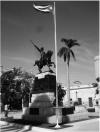Abstract
The work exposes the clarification of the notion of cultural heritage and specifically that of immaterial patrimony. From a verysynthetic idea, but essential, of cultural and immaterial heritage, a deconstruction is realized, of the key elements that structurethis concept, a nucleus or essence that is going to be determined by components, attributes and values. On the other hand,to realize a construction of the evolution of the concept and how the new elements are included −components, attributes andvalues−; it frame the century xx in five periods, which in turn marked changes in the attitudes about the cultural heritage.This study will be analyzing the cultural activities produced in Camagüey, and particularly in the Historical Urban Center, declaredWorld Heritage in 2008. It is analyzed in the frame of the Partial Plan, the components of the immaterial patrimony and they areestablished the policies and strategies for this area, the programs, the actions, and the studies, that will allow his conservation.Apuntes is registered under a Creative Commons Attribution 4.0 International Public License. Thus, this work may be reproduced, distributed, and publicly shared in digital format, as long as the names of the authors and Pontificia Universidad Javeriana are acknowledged. Others are allowed to quote, adapt, transform, auto-archive, republish, and create based on this material, for any purpose (even commercial ones), provided the authorship is duly acknowledged, a link to the original work is provided, and it is specified if changes have been made. Pontificia Universidad Javeriana does not hold the rights of published works and the authors are solely responsible for the contents of their works; they keep the moral, intellectual, privacy, and publicity rights.
Approving the intervention of the work (review, copy-editing, translation, layout) and the following outreach, are granted through an use license and not through an assignment of rights. This means the journal and Pontificia Universidad Javeriana cannot be held responsible for any ethical malpractice by the authors. As a consequence of the protection granted by the use license, the journal is not required to publish recantations or modify information already published, unless the errata stems from the editorial management process. Publishing contents in this journal does not generate royalties for contributors.


